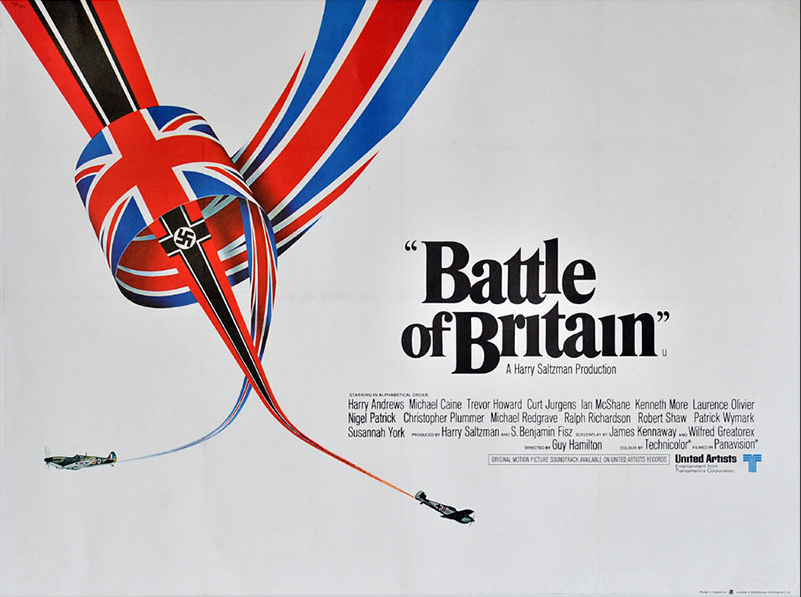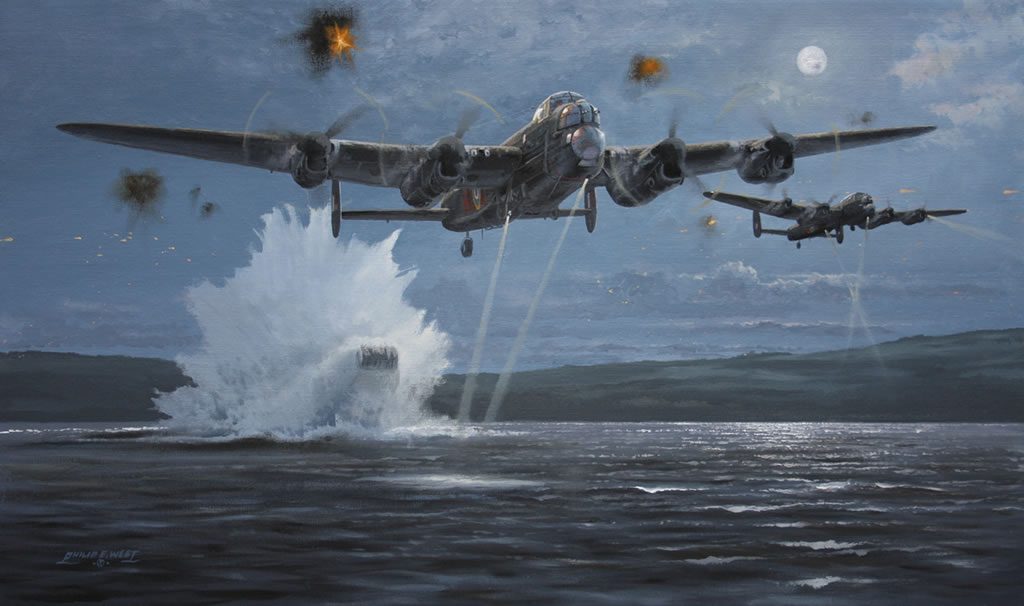
Back in 1969, when I was seven years old, the classic war film ‘Battle of Britain‘ was in the cinemas, and in this instalment of ‘Beautiful Destroyers’ I am going to showcase a superb piece of music from that film, which is an excellent example of musical storytelling.
But first, some background.
During the decades immediately following World War II, many films were made about the War. These movies told stories about the whole spectrum of the War, and depicted history – or near-history – from all theaters of the War. Films like ‘Bridge on the River Kwai‘ (1957), based on a true story of Japanese use of slave labour to build the Burma Railway. 633 Squadron (1964), from the book by Frederick E. Smith, its story loosely based on real-life exploits of crews of the incredible DeHavilland Mosquito fighter-bomber, and by which George Lucas was inspired to create his Death Star Trench attack from the final act of the movie Star Wars: A New Hope. And, of course, The Dam Busters (1955), telling the true story of the legendary 617 Squadron* and their attack on the Ruhr dams on the night of 16/17 May, 1943, using the ‘Upkeep’ mine, also known as the ‘bouncing bomb’.
This is the raid that I often simulate in my personal light aircraft flying adventures, albeit in daylight and a lot higher up than the 100ft height that 617 Sqn flew the attack at. Because they flew at 100ft in the dark. Amazing flying. And the ‘bouncing bomb’ alone weighed like five times the total weight of my Tomahawk aeroplane 😉 And of course there’s the unforgettable and iconic film The Great Escape (1963), depicting, reasonably accurately, the true story of the escape of 70 prisoners of war from the German prison camp Stalag Luft III at Zagan in Poland. Even today, the main theme tune from that film – composed by Elmer Bernstein – is sung by football crowds all across the UK during matches, and has been essentially immortalised. Such is the power of film music.
Anyway, as a young boy I was absolutely fascinated by Battle of Britain, and indeed all the war films of the time. Since my Dad is ex-RAF, and I have a deep interest in military history, and a passion for aviation in general, this is no doubt largely why I have had a lifelong interest in military aviation in all its forms. We always looked forward to Christmas because there would always be some decent war films on the telly.
But the thing about Battle of Britain that I wanted to write about is the way that the climactic battle is done almost entirely to music. In fact, the music tells the story, and it could in fact be thought of as ‘musical storytelling’. The genius of this music – a piece called ‘Battle in the Air‘ by Sir William Walton – is that it captures perfectly the desperate and fraught feel of aerial combat. The breathtaking fear, the extreme danger, the racing, speeding, swirling and chaotic nature of aerial combat; the rapidly manoeuvring fighters and the rattle of their machine guns and cannon. The menace of the German armed forces and the threat of the invasion they were planning. The triumphs, the terror and the tragedy. It’s all there.
What I’m going to do is to let you hear the piece of music first, and then give you a clip from the film itself where the music is actually used. Get a feel for the music and the story it is telling, and then see if it matches up with what you see in the film clip.
This part of the film is narrated almost entirely by the music. Once the music starts, there is very little engine noise, gunfire or anything else, just the occasional bit of monologue from a couple of the actors, and that rarely. The visuals and the music tell the entire story, and it is sheer genius.
September 15th, 1940, the day depicted by the clip, was the height of the Battle of Britain. In the two months leading up to this day, and on the day itself, (which is nowadays celebrated as ‘Battle of Britain Day’), the course of the War in Europe was decided. The hitherto unstoppable Luftwaffe – the German air force – had been defeated for the first time. As a result of this, not long after this day, Hitler decided to ‘postpone indefinitely’ his planned invasion of Britain.
The evocative picture below shows condensation trails (contrails) generated by aircraft operating at extremely high altitudes, fighting over London during the Battle of Britain in the summer of 1940. Yes, that’s Elizabeth Tower, colloquially known as ‘Big Ben’, although that’s actually the name of the bell in the tower, not the tower itself.
“Never in the field of human conflict was so much owed, by so many, to so few”. – Winston Churchill, 20th August 1940
As an additional observation, I’d say that classical music, played by a full orchestra, is generally neither liked nor understood by the general populace. It’s seen as old and stuffy. But in the world of cinema, just about all of cinema music is essentially classical, and is almost always full orchestra stuff. Back in the 70’s and 80’s, there were some forays into synthesiser music – for example Vangelis’s soundtrack to the film Chariots of Fire (1981), and the soundtracks to many science fiction films of the time, such as Dark Star – but these nowadays come across as pretty cheesy, especially the science fiction soundtracks (Chariots of Fire wasn’t too bad in my opinion; for once the synth stuff actually worked). In short, there’s nothing like a full orchestra for a cinematic score.
And the work of the legendary composer John Williams is, in my opinion, some of the finest music ever written, not just in the field of film score music. His work on so many films – Star Wars, Superman, Harry Potter, E.T., – is unsurpassed, and so is his genius.
Yes, music tells the story, usually as part of the screenplay, and usually very well. But today I just wanted to showcases the sheer genius of Battle in the Air, and how it tells the story with very few words and no sound effects audible. I hope you have enjoyed it!
*I’d like to tell a funny and interesting, if somewhat politically-incorrect, story about that film. The RAF officer who led the Dams raid was WgCdr Guy Gibson, and he had a black Labrador dog called ‘Nigger’. It’s an historical fact; deal with it.
As part of the operational planning for the Dams raid, the code word for the destruction of the Möhne dam was the word ‘Nigger’, to be transmitted in Morse code by the wireless operators in the Lancaster bombers taking part in the raid once the dam had been breached. Controversially, because of the somewhat sensitive nature of the dog’s name, some modern TV versions of the film were censored/edited to either blank out Nigger’s name entirely, or replace it with a more ‘acceptable’ name. I hate political correctness, and although I would not go out of my way to offend people, that was the dog’s name, and I am one of those people who thinks that history should be left alone and unchanged, no matter how ‘unacceptable’ something may be deemed to be in these present times.
But what’s funny is this.
Let’s say the dog’s name was redacted to ‘Blackie’. When the Möhne dam is breached in the film, the wireless operators back at base hear the Morse transmission coming in and proclaim joyously, “Blackie! It’s Blackie, sir!” and there are handshakes all around because the job’s a good ‘un and the dam has been breached. Except it’s not ‘Blackie’. Those who can read Morse (and I can) can hear clearly that the Morse message is in fact the original ‘Nigger’, just as it should be. ( _. .. _ _. _ _. . ._. )
These censors are incorrectly assuming that no-one these days knows Morse, a point that, should I be so inclined, I could also get as equally offended about as do those who don’t like the dog’s name. But I don’t get offended…I learned Morse as part of qualifying as a Radio Amateur in 1985 and, although Morse is no longer required as part of the Amateur licence, I still know it and can read and send it proficiently. I also find it very useful when flying at night, as the radio navigation aids I use are identified by a Morse callsign, albeit using a much slower Morse than I am used to reading.
But still, I think the story is funny. A story where politically-correct censors try to find an offence that doesn’t really exist, and thereby create other insults into the bargain. History is best left alone!
Tragically, Nigger was killed by a hit-and-run driver just outside the station gate at RAF Scampton, the Dambusters’ base, on the evening of the raid, not long before the Lancasters set off on their mission. WgCdr Gibson’s wish was that Nigger be buried at midnight that same evening, and this was done while Gibson’s and the other crews were actually carrying out the attacks on the Dams.
Here’s a picture of Nigger’s grave:
…and its position next to one of the hangars at RAF Scampton:



